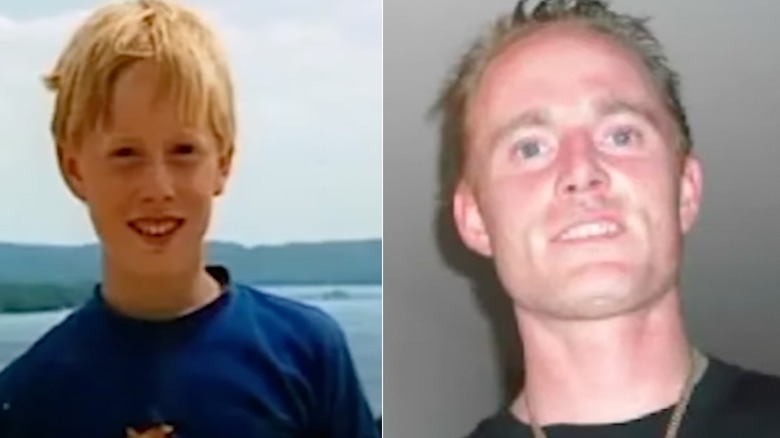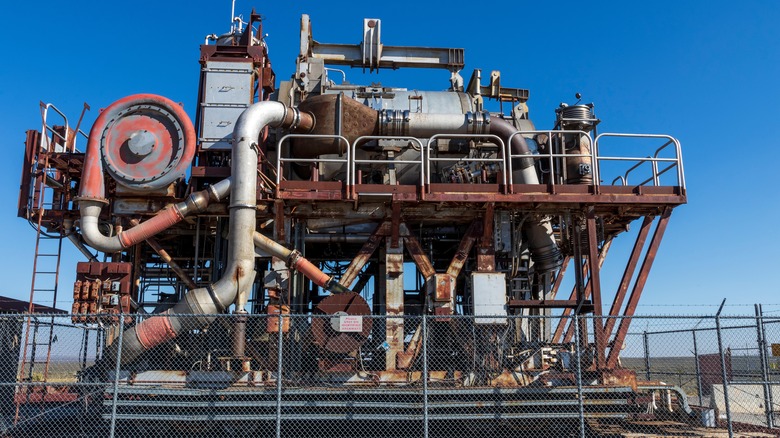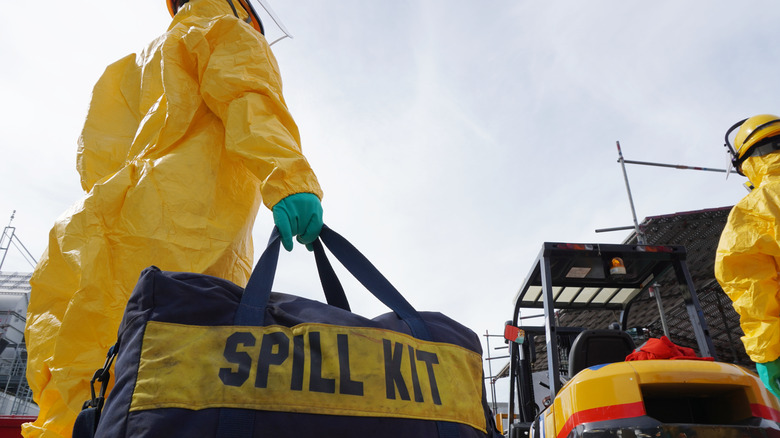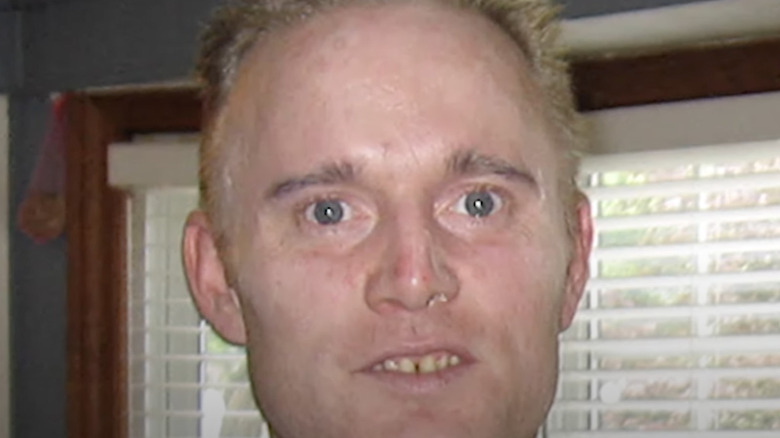Who Is David Hahn, And Why Was He Called The Radioactive Boy Scout?
Back in 1994, there was a lot going on in the world: The ramp-up to the O.J. Simpson trial, the aftermath of the Waco siege, and Snoop Dogg was telling us all about "Gin and Juice." With just those antics crossing viewers' television screens on a daily basis, no one seemed to notice what David Charles Hahn was doing in the shed located in his mother's yard. It wouldn't be until August 1994, when Hahn was finally stopped by police that anyone realized just how far down the nuclear rabbit hole Hahn went ... all before the age of 18.
Born October 30, 1976, David Hahn, aka the Radioactive Boy Scout, developed a deep fascination with chemistry early on, especially after his grandfather gifted him a copy of "The Golden Book of Chemistry Experiments" when Hahn was 10 (via Newsbreak Original). The experiments within the book so enthralled Hahn, he began trialing things on his own. By the age of 12 years old, Hahn already discovered a way to make his own nitroglycerin. Along the way, he came up with the brilliant notion of trying to collect every element on the periodic table, and not just the inert, less lethal ones, either. Hahn became obsessed with the radioactive elements he found on the deeper parts of the periodic table of elements (via Chemeurope).
The Radioactive Boy Scout
Tinkering with chemicals as a kid was one thing, but when David Hahn joined the Boy Scouts, things really became ... irradiated (via IFL Science). Encouraged by his success obtaining field badges, Hahn conducted more and more elaborate experiments. In his quest to procure elements off the periodic chart, Hahn became very clever about where to find his samples. In the smoke detectors throughout his mother's house, he found the radioactive element americium (via Chemeurope). Being a scout, Hahn knew how camping lanterns work. In fact, the Radioactive Boy Scout would eventually learn that the radioactive element, thorium, was used in the making of some types of camping lanterns (via Orau). Interestingly enough, the Coleman Corporation — the manufacturer of camping lanterns — decided in 1990 to replace thorium with yttrium. While not burning nearly as bright as thorium, yttrium does last a lot longer than thorium.
Hahn also managed to procure some radium for himself from clocks. From all these radioactive elements, Hahn was able to construct a type of nuclear reactor known as a breeder reactor by taking a large block of lead and drilling a large hole in it, per Chemeurope. From there, he needed to obtain enough lithium to power the thing, which he got out of a bunch of batteries. Then he fired up the old Bunsen burner and began purifying the thorium. In doing so, he released uranium, a highly radioactive element, and created his very own homemade breeder reactor (via IFLScience).
Obtaining the radioactive goods
While obviously a genius, David Hahn was still just a teenager: clever enough to obtain radioactive elements out of household items, but still not ingenious enough to know exactly what he was doing. Cue the professionals. Hahn pretended to be a professor of physics to help him procure not only information, but something even more valuable that he was aware he couldn't legally obtain as a layperson: radioactive material (via Chemeurope).
Hahn was able to develop a network of professional colleagues and professors that unwittingly guided him in the building of his breeder reactor. It was through this network that he learned how to extract radioactive elements from common household things, like radium from clocks and thorium from camping lanterns. According to Harper's, Hahn went as far as posing as a professor, claiming to be looking for samples to examine at the nuclear facility that he worked at. The Radioactive Boy Scout ended up buying pitchblende from a Czechoslovakian source known for selling radioactive materials to universities.
It's never good acting suspicious
Everything was seemingly going great for David Hahn. He had his fair share of setbacks, but still, the success he was having procuring the radioactive material he needed kept him going. That is, until the early morning hours of August 31, 1994. According to Harper's, around 2 a.m. in the morning, local authorities responded to reports of what looked like a man stealing tires from a car. When they arrived, police questioned Hahn about what he was doing so late in the evening. Not believing his excuses, the officers made the decision to search Hahn's car. What they found amongst the weird collection of discarded scientific equipment was a toolbox.
When 18-year-old Hahn informed the police that the box was radioactive, they arrested him on the spot — suspecting a bomb just waiting inside the metal container. While towing his vehicle back to the police station, the local authorities interviewed the wayward genius. It wasn't long before the Michigan State Police Bomb Squad was called in to take a look at the toolbox still outside in the car. According to Harper's, while the bomb squad didn't find a bomb, they did find enough radioactive material to institute the Federal Radiological Emergency Response Plan.
The feds take over
While the bomb squad picked at the toolbox in David Hahn's car, he remained mostly uncooperative with the police (via Harper's). In fact, it wasn't until three months after his arrest that Hahn finally spilled the beans to the authorities about what was actually going on in his mother's shed. It wasn't a bomb he was building, the Radioactive Boy Scout admitted to investigators; rather, he was just trying to find a way to produce energy from thorium so that he could finally earn the Eagle Scout patch he wanted.
The Environmental Protection Agency, not caring about the teenager's motivations, quickly rolled in, declaring the entirety of his mother's property a Superfund site (via Chemeurope). The cleanup of the shed began earnestly, with the proper containing and disposing of the radioactive material made a priority. All told, the cleanup of the area cost a staggering $60,000. Even with the quick cleanup, however, an estimated 40,000 residents were potentially exposed to Hahn's radiation experiments, according to Harper's.
A genius' sad end
According to Harper's, David Hahn fell into a deep depression after the scandal. Shunned by his town, with folks taking to calling him "radioactive boy," Hahn almost lost the one thing that inspired him to begin with: his Eagle Scout status. Due to his irresponsible experiments that jeopardized the community, many of his scout leaders wanted Hahn stripped of his title. And while he managed to hang onto his ranking, Hahn still sank further into depression.
Hahn's depression was only magnified when his hopes of becoming a nuclear specialist were all but dashed, due in part to his being banned from ever touring nuclear facilities as part of his crime (via Chemeurope). Eventually finding his way into the military, Hahn's life took a directionless turn over the next decade. He was eventually arrested again in 2007 for theft of smoke alarms (via World Nuclear News). Sentenced in 2015, David Charles Hahn died just a year later. Ars Technica reported that while Hahn did die, it wasn't from radiation exposure, as might be expected. It was eventually determined that Hahn's actual cause of death was alcohol poisoning.
If you or anyone you know needs help with addiction issues, help is available. Visit the Substance Abuse and Mental Health Services Administration website or contact SAMHSA's National Helpline at 1-800-662-HELP (4357).





